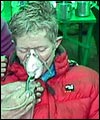The body goes through very complex changes at altitude and I cannot hope to explain everything here. Our understanding of altitude physiology is rapidly expanding. Entire textbooks have been written on what I will try to explain in a short article. I hope I can enlighten you to some of the changes our bodies go through while attempting to climb to the roof of the world.
HIGH ALTITUDE
As our team climbs towards the summit of Everest, we are exposed to decreasing barometric pressure. Barometric pressure (air pressure) falls with increasing altitude. Oxygen contributes about 21% to barometric pressure, therefore, as we ascend in elevation, our bodies are exposed to less oxygen. This is the main cause of altitude problems - hypoxia. For example, at Everest Base Camp (5300m), we are exposed to about half as much oxygen as at sea level. At the summit, each breath contains about one third the oxygen at sea level.
ACCLIMATIZATION
I'm sure many people have seen the film Vertical Limit. Although we would all love to fly to Base Camp in a helicopter, have a rocking BBQ and then go for the summit the next day, the truth is, our bodies would not allow us to do this. A rapid ascent to the summit of Everest would cause unconsciousness and death within several minutes. However, with a slow ascent from sea level, our bodies can adjust to the thin air and allow ascent even without oxygen.
We term this adjustment to altitude "acclimatization." Physiologic changes in respiration, circulation, blood, and tissues increase the oxygen delivery to our body and the body's ability to withstand less oxygen. Success of acclimatization depends on rate of ascent, severity of the stress and an individual's physiology.
Individual ability to acclimatize varies - some adjust easily and quickly, while others may take longer and develop symptoms of altitude illness. There are even an unfortunate few who cannot acclimatize at all! People who live at high altitude during childhood seem to get the maximum benefit from the changes of acclimatization, especially in terms of exercise performance. This certainly explains our Sherpa colleagues, who perform very well at high altitude.
Respiratory Changes:
One of the first changes we notice at altitude is a faster breathing rate. This can start as low as 1500m. This is termed Hypoxic Ventilatory Response (HVR). The HVR varies from person to person and is also affected by stimulants (such as coca and caffeine), and depressants (such as alcohol and antihistamines). Physical fitness appears to have no effect on the HVR. A good HVR enhances acclimatization, while a poor HVR may predispose one to altitude illness.
As our breathing rate increases, we take in more oxygen, but we also breath out more carbon dioxide, which causes chemical changes in the blood. Within 24 to 48 hours, our kidneys try to counteract these chemical changes by excreting bicarbonate. Basically, what this means is that we pee lots while acclimatizing. This process of compensation is sped up by a drug called Acetazolimide (or Diamox), but more about that later.
Circulatory Changes:
High altitude stresses the body. In response to this, stress hormones are released into the blood. This causes an initial mild increase in blood pressure and heart rate. With time at altitude, resting heart rate returns to that at sea level. However, our maximum heart rate actually decreases. As you can imagine, at some point, resting and maximum heart rates converge as the limits of acclimatization are approached.
The volume of plasma (blood minus the cells) also drops due to the increased amount of peeing (see above). Plasma volume actually drops about 15% in the first three days. Obviously it becomes important for us to stay well hydrated during acclimatization. It is not uncommon to drink five or six 6 liters a day!
The pulmonary vessels constrict with increase in altitude. This causes an increase in pulmonary artery pressure. This increases even more with exercise. This is one of the factors which contributes to pulmonary edema, which I will explain below.
Blood Changes:
Erythropoietin (EPO) stimulates the bone marrow to produce more red blood cells (which are responsible for carrying oxygen). This hormone is secreted by the kidneys in response to low oxygen levels. Within four to five days, new red blood cells are in circulation. Over the weeks at altitude the body continues to produce more red blood cells to carry the sparse oxygen from the lungs to the tissues where it is needed. The blood also undergoes chemical changes, which helps oxygen bind in the lungs. This raises oxygen saturation, or the amount of oxygen carried by each red blood cell.
Tissue Changes:
To increase needed oxygen delivery, the amount of small blood vessels (capillaries) in the muscles increase. The muscles also decrease significantly in size (due to atrophy). This is actually a benefit as the oxygen has less distance to travel in a smaller muscle.
Sleep Changes:
It is very common to have sleeping difficulties at altitude. Breathing is normally controlled by carbon dioxide levels in the blood; when carbon dioxide levels rise, our brain tells us to breath. The backup system is oxygen levels in the blood. If oxygen levels drop, again our brain says breath. When we breath rapidly at altitude, we blow off carbon dioxide - our brain senses low levels - we stop breathing. When the oxygen level drops from not breathing, our brain signals to breath. Then we breath quickly again and blow off carbon dioxide... It is a vicious cycle of rapid breathing and no breathing.
The non-breathing phases can last 30 seconds or more. This is termed periodic breathing and is very common while acclimatizing. As you can imagine, it can be quite disruptive to normal sleep. It is common to wake suddenly with a feeling of suffocation, and be gasping for breath. As acclimatization continues, this phenomenon decreases, but does not disappear totally. The drug Acetazolimide (Diamox) decreases periodic breathing substantially, and is commonly used as a sleep aid while acclimatizing.
Deterioration:
Altitudes of approximately 5800m are the limit of long-term habitation (of course this varies by individual). Problems of weight loss, increasing lethargy, poor sleep, and weakness become realities of living at high altitude. The higher the elevation, the quicker the deterioration. Above 8000m (known affectionately as "The Death Zone"), this deterioration is so rapid that death can occur in just a few days. Most climbers on Everest use supplemental oxygen, which greatly improves performance in The Death Zone.
Weight loss is a big concern on long expeditions to altitude. Two problems contribute to this: poor appetite and problems with absorption of nutrients. The appetite decreases with altitude, to the point that on summit day climbers have only been able to stomach a few Pringles or a candy bar. Also, the body only absorbs about half as much fat and three quarters as many carbohydrates as at sea level. It is not uncommon to lose 10% of one's body weight on an Everest climb! We are thinking of starting the "Everest Weight Loss Program" - a sure success!
— Bryce Brown, Alpine Ascents International Expedition Doctor and MountainZone.com Correspondent
 EMAIL THIS STORY TO A FRIEND
EMAIL THIS STORY TO A FRIEND





